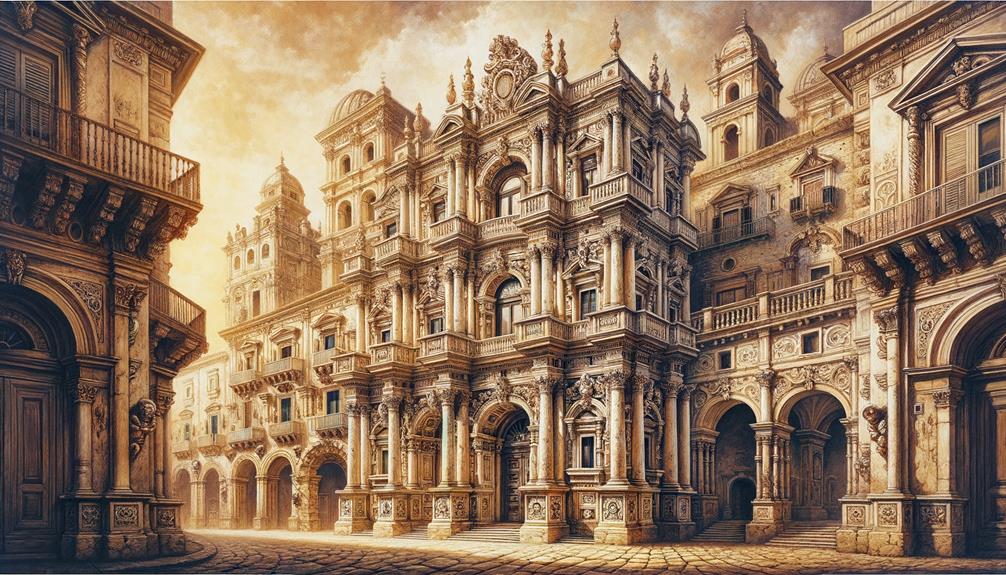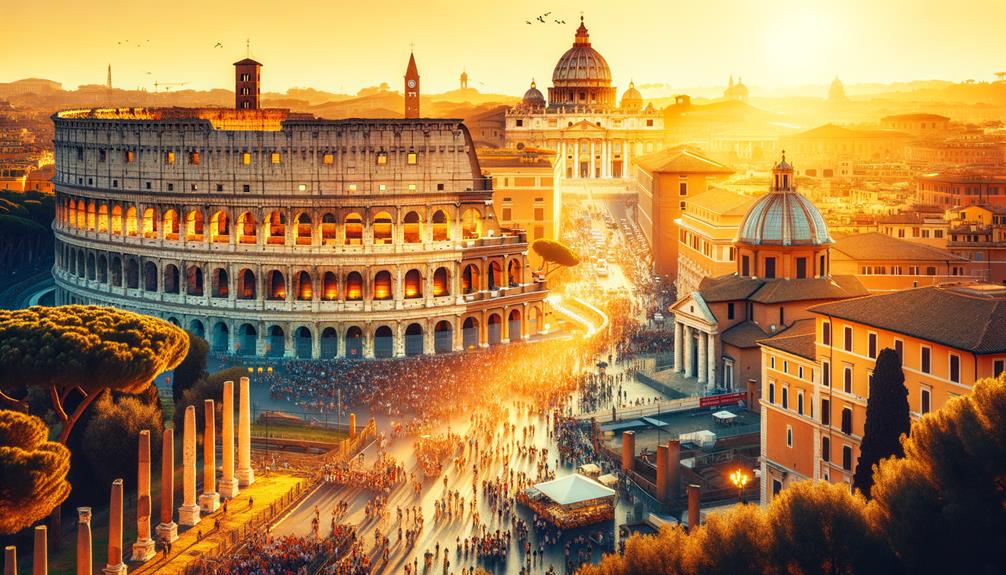Strolling through the sun-soaked streets of Lecce, I'm constantly amazed by the city's stunning Baroque architecture. The Basilica di Santa Croce and Lecce Cathedral are like stone lacework, full of intricate carvings and angelic figures. In contrast, the Castle of Charles V stands as a robust reminder of the past. Wandering into Piazza Del Duomo, the calm amidst all the grandeur feels almost surreal. But it's the ancient Roman Amphitheatre, with its weathered arches, that truly shares the tales of time.
History of Baroque in Lecce
Lecce's Baroque history is a vivid story of artistic passion that began in the late 16th century, transforming the city's architecture into a stunning display of ornate facades and intricate stonework. Strolling through the narrow streets, you can almost sense the dedication poured into every curve and flourish, especially when standing before the Basilica di Santa Croce.
Francesco Antonio Zimbalo, one of the prominent architects, made use of the local pietra leccese, a soft, golden limestone ideal for detailed carvings. This stone, easy to shape yet durable, became the foundation for Baroque art in Lecce. The way light and shadow play on its surface creates mesmerizing scenes of myth and nature.
This Baroque transformation wasn't just about grand designs; it signaled a cultural shift. Lecce's architects and sculptors broke away from past traditions, embracing a newfound sense of freedom and exuberance. The city's architectural evolution reflected a collective desire for beauty and expression, a sentiment that still resonates today. Each ornate balcony and sculpted cherub tells the story of a city that found its voice in stone.
Basilica Di Santa Croce
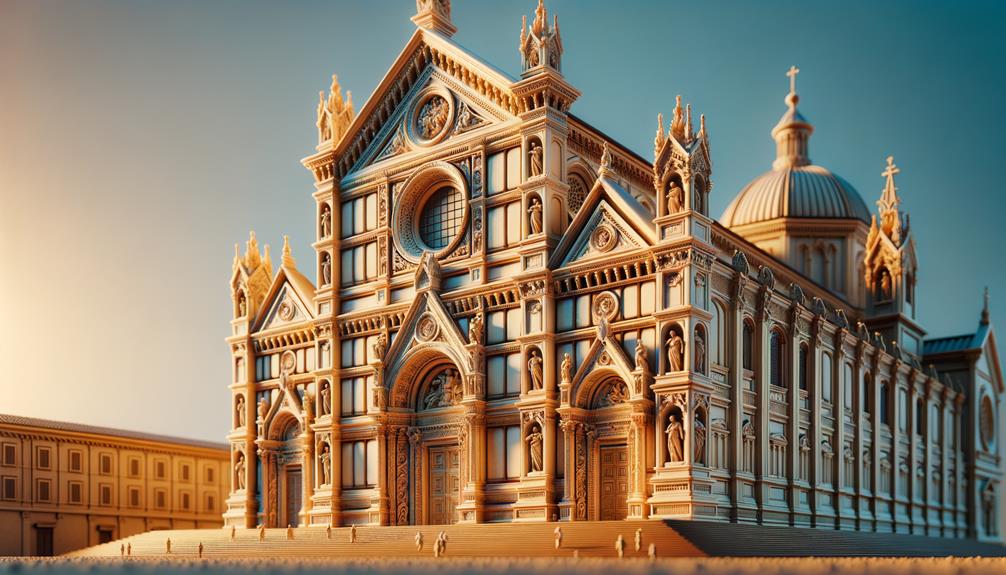
As I stand before the Basilica di Santa Croce in Lecce, I'm struck by the sheer complexity and beauty of its facade. This Baroque marvel is like a visual banquet for the eyes. The 16th-century sculptures on the front are a mix of Biblical stories, mythological tales, and everyday scenes, all showing off the incredible talent of local stonecarvers. Each figure, from the cherubs to the mythical creatures, seems to tell a unique story, encouraging you to pause and reflect.
| Facade Elements | Features |
|---|---|
| Sculptures | Biblical, mythological, everyday life scenes |
| Cherubs | Delicate, emotive expressions |
| Rose Window | Large, intricately designed |
| Altarpieces | Ornate, detailed craftsmanship |
Inside, the basilica continues to amaze. The large rose window fills the space with light, casting a calm glow on the detailed altarpieces and the gorgeously decorated ceiling. Local artists have painted frescoes on the ceiling, adding even more layers to this architectural wonder. Funded by the noble D'Enghien family, the Basilica di Santa Croce stands as a testament to Baroque elegance and artistic mastery. It's a place where you feel time slow down, urging you to take in every detail and appreciate the timeless beauty around you.
Lecce Cathedral
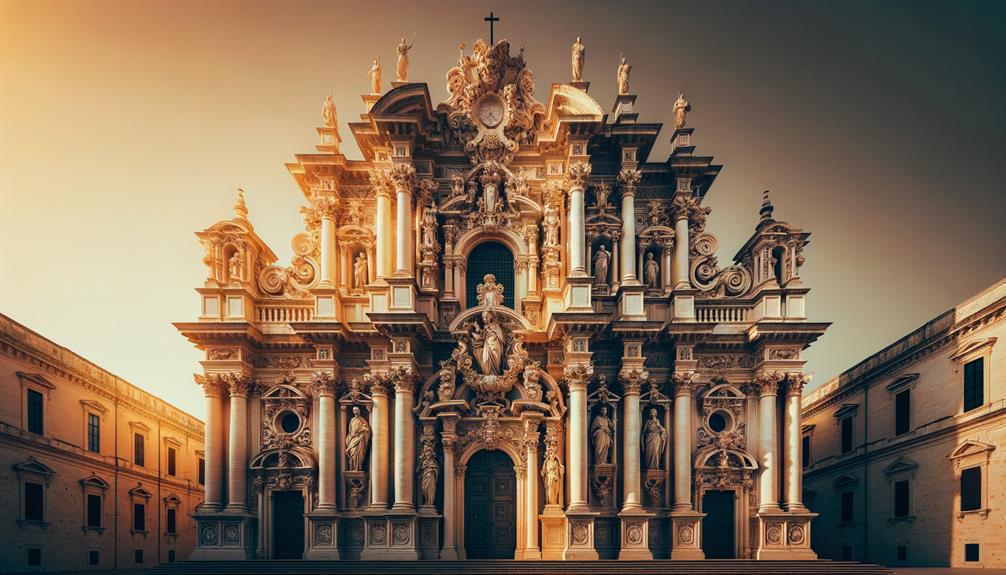
The first time I saw Lecce Cathedral, its detailed facade was like a visual banquet, each carving telling a unique story. Walking inside, I was struck by the historic art, with rich tapestries and stunning frescoes. This cathedral isn't just a place to pray; it's a cultural gem that showcases Lecce's baroque beauty.
Ornate Facade Details
Walking through the lively streets of Lecce, it's impossible not to be drawn to the stunning stone carvings on the facade of Lecce Cathedral. Each detail tells a story of incredible craftsmanship and baroque grandeur. Under the Mediterranean sun, the carvings cast intricate shadows that play across the limestone, each figure and flourish a testament to the artisans' skills.
The carvings feature scenes of saints, angels, and mythical creatures, blending sacred and fantastical themes in a mesmerizing display. The facade isn't just something to look at; it's something to feel, inviting you to trace the lines and textures with your fingers.
| Detail | Description |
|---|---|
| Intricate carvings | Depict saints, angels, and mythical creatures |
| Ornate facade | Combines sacred and fantastical elements |
| Elaborate designs | Showcases artisans' skill and creativity |
Standing before this work of art, I feel deeply connected to the past and to the artisans who carved these stories into stone. It's a powerful reminder of the endless creativity that defines human expression, a creativity that transcends time and place. The facade of Lecce Cathedral is more than just architecture; it's a celebration of artistic freedom.
Historic Interior Art
Walking into Lecce Cathedral, I'm instantly struck by the incredible frescoes and gilded altars that speak to the rich spiritual and artistic legacy of this baroque gem. The air feels heavy with history, with every corner filled with intricate sculptures that showcase unparalleled devotion and craftsmanship. These sculptures, skillfully carved from the renowned local stone, have a warmth and texture that almost bring them to life.
My gaze is drawn upward to the stunning rose window, its stained glass creating a colorful mosaic across the cathedral's interior. This window is more than just a piece of architecture; it's a source of spiritual illumination that bathes the space in divine light. The play of light and shadow adds depth to the frescoes, making saints and angels seem to float in their heavenly realms.
Each altar celebrates the elaborate artistry of the Baroque period, adorned with gold leaf and detailed carvings that stand alongside the finest works of art. The contrast between the solid local stone and the delicate gilding creates a visual harmony that is both mesmerizing and humbling. In this sacred space, time appears to pause, allowing me to fully take in the cathedral's historic interior art.
Palazzo Del Seggio
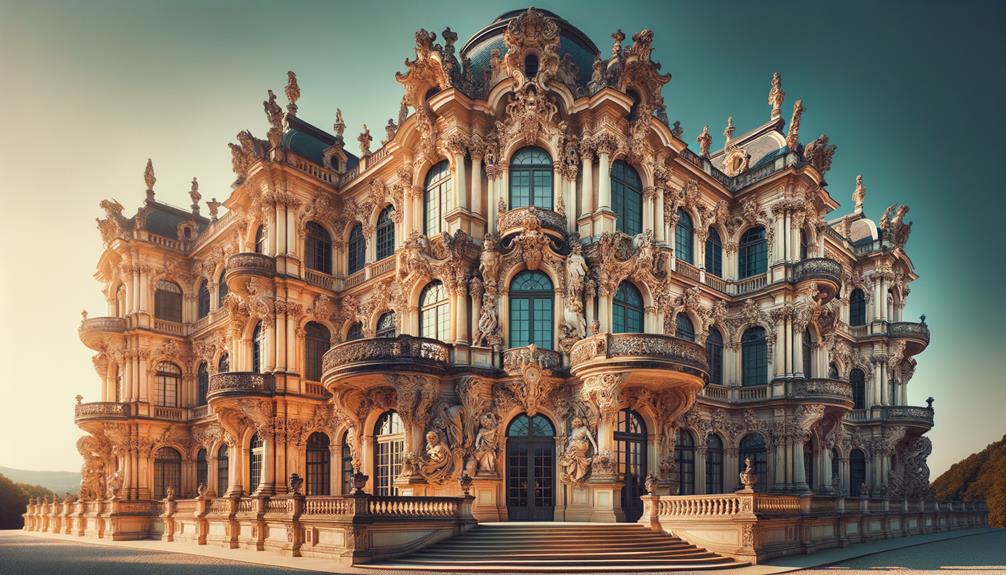
In the heart of Lecce, the Palazzo Del Seggio, or the Sedile, stands as a testament to the city's rich Baroque heritage. Strolling through Lecce's historic center, I was immediately drawn to this elegant structure. Its façade, adorned with intricate carvings and ornate details, reflects the Baroque style's dynamic shapes and dramatic flair. Dating back to the late 16th century, the Palazzo del Seggio captures the essence of that artistic period.
| Feature | Description |
|---|---|
| Location | Piazza Sant'Oronzo, Lecce |
| Architectural Style | Baroque |
| Built | Late 16th century |
| Original Use | Seat of the local government |
| Current Use | Cultural events and exhibitions |
Standing before the Palazzo del Seggio, I was struck by the craftsmanship. The arches and columns interplay with light and shadow, creating a visual masterpiece that speaks of an era when art and architecture were deeply connected. Once the seat of the local government, this building now hosts cultural events, breathing new life into its historic halls. It beautifully combines past and present, offering a glimpse into Lecce's Baroque legacy while continuing to play a vital role in the community.
Castle of Charles V

What's so fascinating about the Castle of Charles V in Lecce? Built in 1539 by Emperor Charles V, this fortress showcases a mix of Renaissance and medieval architecture that still draws visitors today. Walking through its grand entrance, you're immediately struck by the blend of Renaissance elegance and medieval strength. The castle's trapezoidal design and four sturdy towers at each corner convey both majesty and protection, a visual story of defense against Ottoman invasions.
The castle's interior is a journey through time. Originally a royal residence, it later became a military stronghold and even a prison. Nowadays, it serves as the headquarters for the Department of Culture, transforming it into a bustling cultural center. The thick stone walls seem to whisper tales of the past, while art exhibits and cultural events inject new energy into its ancient hallways.
Visiting the Castle of Charles V is more than just a walk through history; it's a dive into Lecce's cultural essence. The castle stands as a testament to the city's resilience and creativity, reflecting its enduring spirit and rich heritage.
Piazza Del Duomo
Leaving the impressive walls of the Castle of Charles V behind, you find yourself heading towards the heart of Lecce's spiritual and artistic center, Piazza del Duomo. This grand square, tucked away like a hidden gem, unveils itself with a sense of drama. The Duomo di Lecce proudly stands at its center, a stunning example of Baroque art. Its intricate façade, adorned with angels, saints, and swirling stonework, immediately catches your eye and sparks the imagination.
To the right, the Bishops Palace exudes stately elegance. Its grand balconies and ornate windows hint at tales of ecclesiastical power and reverence. The palace's harmonious design beautifully complements the cathedral, creating a visual symphony that resonates deeply.
Strolling through Piazza del Duomo, you can't help but feel a sense of liberation—an invitation to pause and reflect. Here, history is palpable, woven into Lecce's very streets. The square's quiet reverence contrasts with its vibrant details, offering a peaceful retreat where you can immerse yourself in Baroque beauty. This is Lecce at its most enchanting, a place where the past and present blend seamlessly.
Roman Amphitheatre
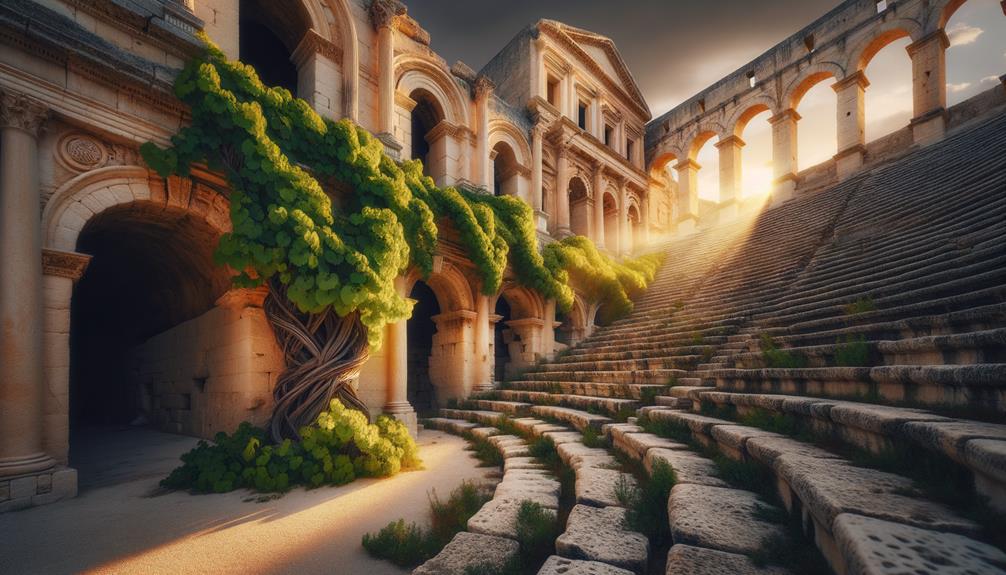
Strolling through Lecce, I was struck by the sight of the Roman Amphitheatre, an ancient structure right in the city's center. Its worn stones seem to tell stories of gladiators and cheering crowds, blending effortlessly with the lively Baroque surroundings. This mix of historical periods offers a vivid glimpse into Lecce's rich past and architectural development.
Historical Significance
In the center of Lecce, the Roman Amphitheatre stands as a testament to the city's rich history and culture. Walking through the lively Piazza Sant'Oronzo, you can feel the centuries come to life. This ancient structure, partly hidden beneath the modern city, tells stories of gladiators and cheering crowds.
Lecce is often praised for its Baroque architecture, but its historical roots lie in this amphitheatre, a nod to its Roman past. The mix of Roman and Baroque elements in Lecce creates a unique cultural blend, inviting you to delve deeper into its history.
| Aspect | Details |
|---|---|
| Era | Roman Empire |
| Purpose | Entertainment, public events |
| Status | Archaeological site |
| Impact | Connects ancient and modern Lecce |
Standing before the amphitheatre's remains, it's clear how history endures and coexists with the present. It's more than an archaeological site; it's a link between different eras. The amphitheatre enriches Lecce's story, merging its Roman origins with later Baroque touches, painting a vivid picture of time's passage. Here, freedom feels real, as if the stones themselves speak of an enduring spirit.
Architectural Features
The Roman Amphitheatre in Lecce, with its grand arches and weathered stones, feels like a direct link to ancient times. The scale and intricate design are truly captivating, a testament to a past era. Walking down into the arena, where gladiators once fought and crowds gathered, brings a strong sense of connection to history.
The amphitheatre's simpler, more robust style contrasts with the elaborate Baroque buildings around it, yet they complement each other perfectly. While Baroque architecture in Lecce is known for its detailed facades and ornate decorations, the amphitheatre's raw stone and open design showcase a different kind of beauty—one focused on functionality and durability.
Standing among these ancient ruins, I can't help but feel awe-struck. The mix of the Roman Amphitheatre with Lecce's Baroque masterpieces highlights the city's rich cultural history. More than just an architectural wonder, the amphitheatre symbolizes resilience and creativity through the ages. It shows that in Lecce, history is not just preserved; it's lived, breathed, and celebrated in every stone and archway.
Frequently Asked Questions
What Is the Baroque Architecture of Lecce?
Lecce's Baroque architecture is truly something to behold. The buildings stand out with their lively facades and detailed carvings. The local pietra leccese limestone gives everything a warm, glowing look. Twisted columns and elaborate balconies add a touch of wonder and creativity to the scene.
What Is the City of Lecce Known For?
Lecce is truly a gem, vibrant with Baroque elegance. Walking through its streets is like flipping through a living history book. Each detailed facade tells stories of art and heritage, captivating those who find joy in beauty and culture.
What Is Special About Baroque Architecture?
Baroque architecture stands out with its lively shapes, detailed decorations, and striking contrasts. I really appreciate how it embodies grandeur and emotion, making spaces feel vibrant and thrilling. It's a true display of artistic freedom and bold creativity.
What Is the Most Famous Architecture in the Baroque Period?
"People often say 'beauty is in the details,' and that's certainly true for Baroque architecture. The most famous example from this period is St. Peter's Basilica in Rome. Its grand design, flowing curves, and detailed decorations draw in anyone who appreciates artistic freedom."

